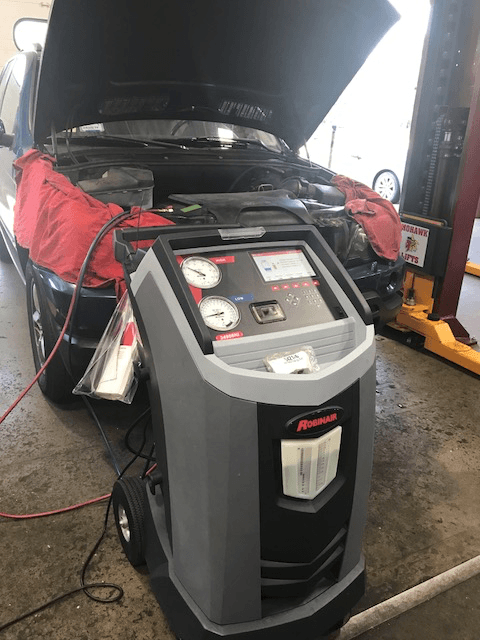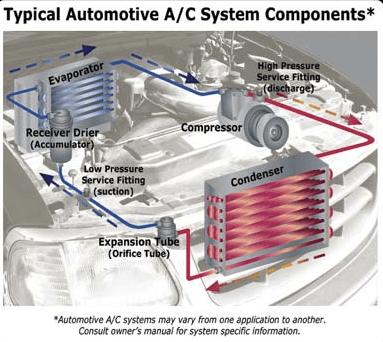The AC system in your vehicle is similar to the one in your home, but it’s wedged into an area that runs to temperatures above 250 degrees and is regularly exposed to rattling and rolling everywhere your vehicle goes! Over time, these factors cause the system to leak refrigerant and lose the ability to remove heat and produce and circulate cold air. Because it’s a pressurized, sealed system, proper maintenance requires a skilled technician with the right equipment.
Don’t end up hot and sweaty on the side of the road! Check out the information below to learn how your system works and the kind of service it requires.
Common maintenance

- AC Performance Test. Testing is important to check the levels of refrigerant and the gases in your system. It’s a simple diagnostic whereby your vehicle is hooked up to special AC equipment and can be done in under an hour, usually at a cost less than $100.
- Dye Test. Using a black light, the technician does a visual scan of the system looking for leaks. Since the AC contains a special dye, leaks can sometimes be detected, and faulty hoses or fittings adjusted to alleviate them.
Vital AC System Components
- Compressor. The most important part of the cooling system where the refrigerant resides. It is actually a pump (powered by a serpentine belt) that circulates refrigerant throughout the system to regulate temperature. Repairs to the compressor can be the most costly because they are labor intensive and require more expensive parts.
- Condenser. Found in front of the radiator in most vehicles, it is responsible for making the air cold. The condenser needs to be inspected periodically for signs of damage or corrosion. Because of its location, it is susceptible to debris build up from rocks, bugs, etc. that can cause clogs. Usually, an external cleaning or internal flush will clear it, and replacement should only be needed if the unit is corroded or the clogs can't be cleared.
- Receiver/Dryer. This acts as temporary storage for oil and refrigerant and traps debris and absorbs moisture. Excessive moisture can cause corrosion in the AC system, possibly degrading its performance. Whenever the system is opened for service, the receiver/dryer should be replaced to keep it operating properly.
- Expansion Valve/Accumulator. Controls the amount of refrigerant that enters the evaporator. Each time the AC system is opened for service, this will need to be changed.
- Evaporator. Cools the air and removes moisture. Because of its location under the dash, the evaporator is the most involved repair in the system. The whole dash needs to be removed (a very labor intensive process) in order to access it.
- Ventilation System. This is the part of the system where the blower motor forces cooled air into the car’s cabin. Failure of this system could be caused by a blown fuse, bad relay, nonfunctioning or damaged blower motor, or clogged intake. Your technician should be trained to diagnose and repair all of these issues to keep your cabin comfortable.
- Hoses and Connectors. Various hoses and connectors are found throughout the AC system. Replacing a leaky hose or tightening a loose connector are simple repairs.
Here’s a graphic to show you what each component looks like and where it’s located.

Common Warning Signs That Your AC System Needs Servicing
- Blowing Hot Air or Not Blowing Cold Air. This is the most common sign that maintenance is required. Inspection and testing of the system will determine the cause, which can often be as simple as low refrigerant level or a leak.
- Greasy Film (on any of the AC components). This indicates that you most likely have a leak that needs to be addressed before a recharge can be successfully performed. Accumulation of dirt and oil can cause a visible greasy film around connections and fittings where a leak occurs.
- No Air or Low Performance. If the fan doesn’t even come on, you may be out of refrigerant. Most systems will automatically shut down when this happens to protect the compressor. Other causes could include an obstruction in the condenser or a fault in the blower unit.
- Weird Noises. If you hear clanking when you turn on your AC, it is probably caused by a blockage or obstruction but could also indicate that parts of the system are worn out or faulty and in need of replacement parts.
- Stinky Air. This could simply require a new cabin air filter, but if a drain is clogged, causing mold to accumulate on the evaporator, you will need a BG Evaporator service that uses a special foam to kill mold and mildew. It sanitizes the air ducts and evaporator unit and will usually cost around $200.
- Knocking or Rumbling Noises. Loose mounting hardware around the area of the compressor could cause these types of noises. Tightening all connectors may be a simple fix to the problem.
- Puddle of Water Under Your Vehicle. It is perfectly normal for the condensation from your AC unit to drain out of your vehicle and puddle under your car. However, if you see water stains inside, that’s an indication of a clog that needs immediate attention.